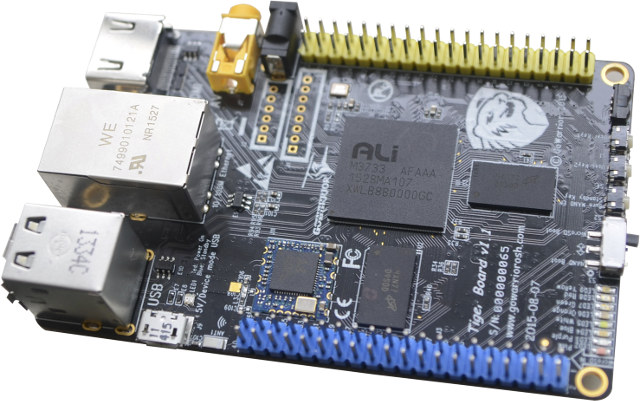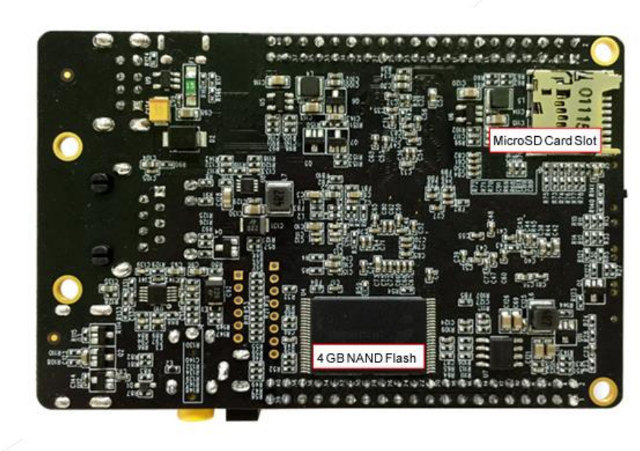There was a time when development boards were really hard to get for individuals with companies not wanting to waste their time with hobbyists, but the maker revolution changed all that, and now many companies want to get involved in “open source” board for the developer’s community. The latest board trying to emulate the Raspberry Pi is GoWarrior Tiger powered by ALi M3733 dual core cortex A9 processor with 1GB RAM, 4GB Flash, Ethernet and WiFi, HDMI and AV output, and two 40-pin expansion headers.

Tiger board specifications:
- SoC – ALi M3733-AFAAA dual Cortex A9 processor @ 1.0 GHz with ARM Mali-400 MP2 GPU
- System Memory – 1GB DDR3; dual channel 1600 MT/s, 800MHz
- Storage – 4GB on-board NAND Flash + micro SD slot
- Video & Audio Output – HDMI 1.4 port up to 1080p, with support for HDCP and CEC, 3.5 mm AV jack
- Connectivity – 10/100M Ethernet, 802.11 b/g/n WiFi and Bluetooth 4.0
- USB – 2x host 2.0 host ports, 1x micro USB device port for power, connect to computer, and flash the NAND chip.
- Expansion – 40-pin Raspberry Pi compatible header (J3) and 40-pin header (J4) with up to 63 GPIOs multiplexed with I2C, SPI, 2x UART, digital VOUT, digital VIN, SD, PCM, SSI, etc…
- Debugging – UART0 in J4 header gives access to the serial console, and unpopulated JTAG header
- Misc – 11x LEDs for power, Ethernet, and users (8x), 3x buttons, selection switch for NAND flash or micro SD boot, IR receiver
- Power Supply
- 5V via DC jack or micro USB port
- PMU with support for RTC, IR/Key standby and resume, system deeo standby mode compliant with EU green power standard.
- Dimensions – 93.2 x 59.7 mm
 The company plans to provide at least three operating systems for the board with GoDroid (Android), GoBian (Debian), and GoTDS (FreeRTOS), but so far only GoDroid is available for download, and there are some repositories on GoWarrior’s github account related to GoBian. All documentation is currently only available for GoDroid, and you can also find some hardware design files such as the schematics (PDF only), PCB layout (.pcb), system reference manual, datasheet and so on. So documentation appears to be decent for the hardware and Android, and they also have Chinese and English forums for support.
The company plans to provide at least three operating systems for the board with GoDroid (Android), GoBian (Debian), and GoTDS (FreeRTOS), but so far only GoDroid is available for download, and there are some repositories on GoWarrior’s github account related to GoBian. All documentation is currently only available for GoDroid, and you can also find some hardware design files such as the schematics (PDF only), PCB layout (.pcb), system reference manual, datasheet and so on. So documentation appears to be decent for the hardware and Android, and they also have Chinese and English forums for support.
The board used to be available on eBay for $79 shipped, but it can only be found on Taobao right now for 399 CNY (~$62). More details can be found on GoWarrior community website.

Jean-Luc started CNX Software in 2010 as a part-time endeavor, before quitting his job as a software engineering manager, and starting to write daily news, and reviews full time later in 2011.
Support CNX Software! Donate via cryptocurrencies, become a Patron on Patreon, or purchase goods on Amazon or Aliexpress





Note that that is most likely 4Gbits worth of NAND flash, in other words, 512MB, not 4GByte.
@TLS
That’s the chip: Micron MT29F32G08CBADA (32 Gbit flash) -> https://www.micron.com/parts/nand-flash/mass-storage/mt29f32g08cbadawp?pc={80EFFAAD-26CB-4D06-84BC-0E3274B960A9}
Emm maybe I’m missing something but why is this so damn expensive ?
@Marius Cirsta
I told them it looked a bit expensive for this feature set.
Somewhat similar to Orange Pi 2 for $32 + 4GB NAND flash.
So something around $40 to $50 (with shipping) would be more like it.
@Jean-Luc Aufranc (CNXSoft)
Well given the price of the pine64 even $40 is too much. For $40 I can get a 2GB, quad core ARM64 with not flash , sure but $5 gets you a decent SD card so …. Not to mention that the sunxi community and all that … so I’m not really sure who this one is for.
@Marius Cirsta
PINE64+ with 2GB + class 10 micro SD + WiFi and Bluetooth + IR receiver should probably be around $55 shipped.
But you’re right that if sunxi community gets involved on Pine64 project, it will greatly help with software. Olimex is also on-board with their laptop project based on A64.
@Jean-Luc Aufranc (CNXSoft)
I guess we’re spoiled these days…. I wouldn’t buy any board that’s not 64bit unless it’s really cheap or a Rpi. I just bought a Rpi 2 because it has really good support and there’s the promise of an open source GPU driver which is not something you can easily get for an ARM board.
@Jean-Luc Aufranc (CNXSoft)
That’s quite surprising and partially explains the high cost, as RAW NAND at that kind of size is not that cheap and it’s not something I expected to see on an oddball board like this. Why not simply use eMMC, as it’s far more reliable and about the same cost?
It only makes sense investing in this if you’re going to build a STB based on the ALi chipset, otherwise I’d say you’re wasting your money.